Urinalysis

Urinalysis is a common part of routine medical screening, and can be used to determine many disorders before symptoms arise. Urinalysis is especially useful in the preliminary screening for diabetes, liver diseases, haemolytic diseases, urogenital, and kidney disorders. Rapid Response™ Urinalysis products aids healthcare professionals and at home users in assessing liver and kidney health.
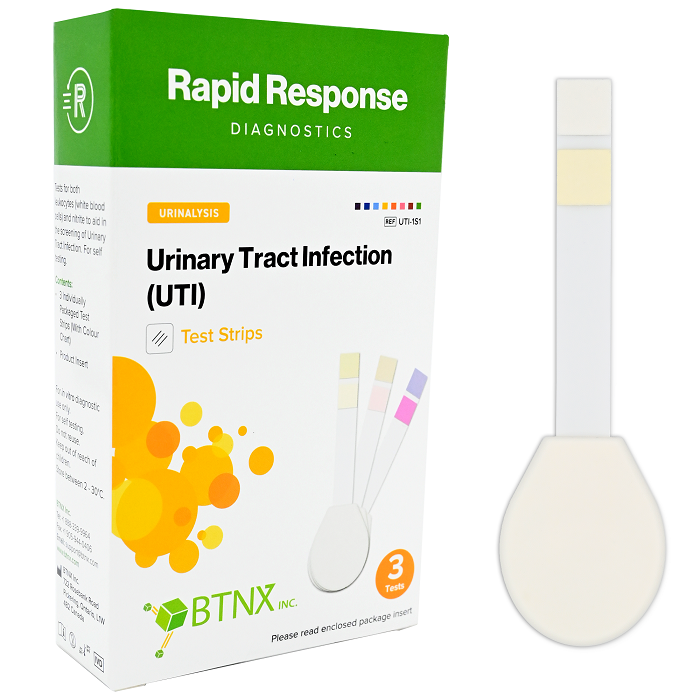
Format: Strip
Kit Size: 3 Tests / Kit
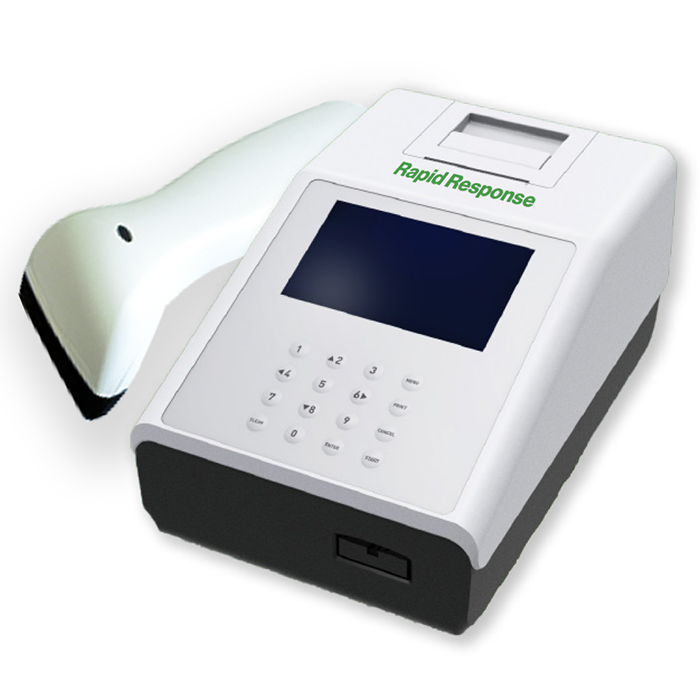
Format: Strip
Kit Size: 1 Unit
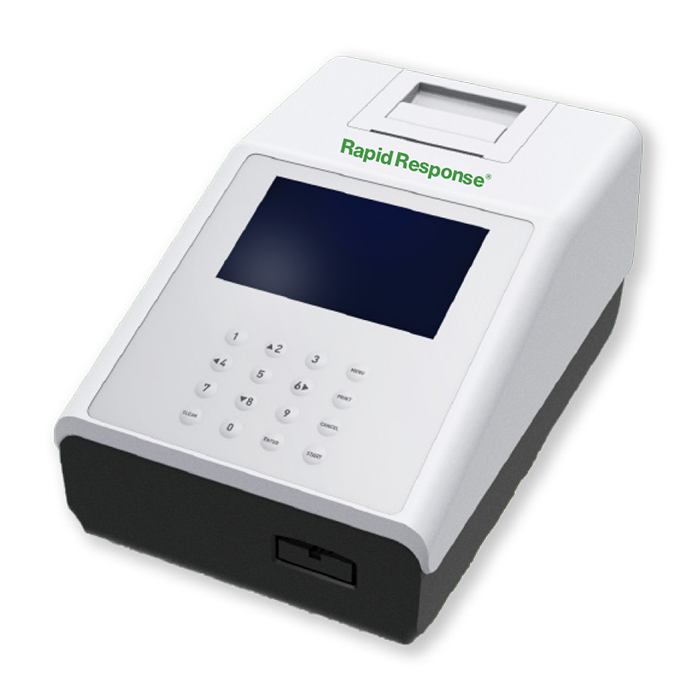
Format: Strip
Kit Size: 1 Unit
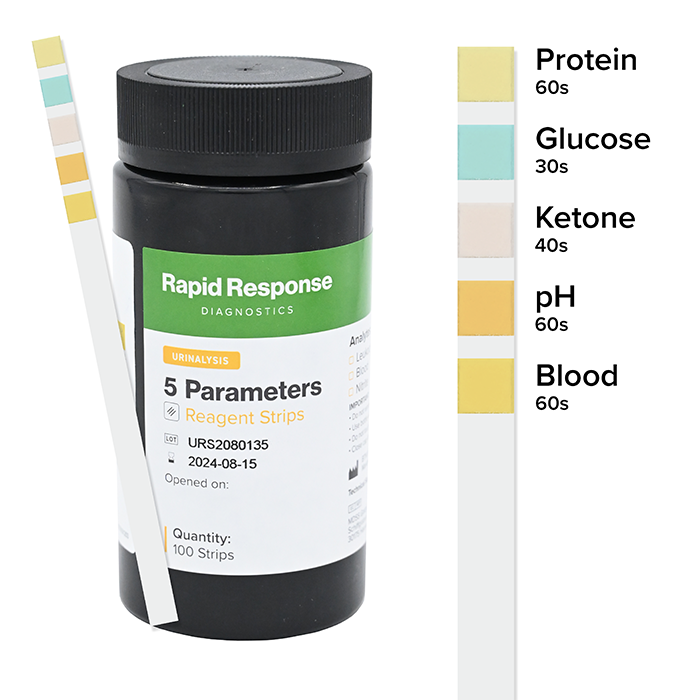
Format: Strip
Kit Size: 100 Tests / Kit
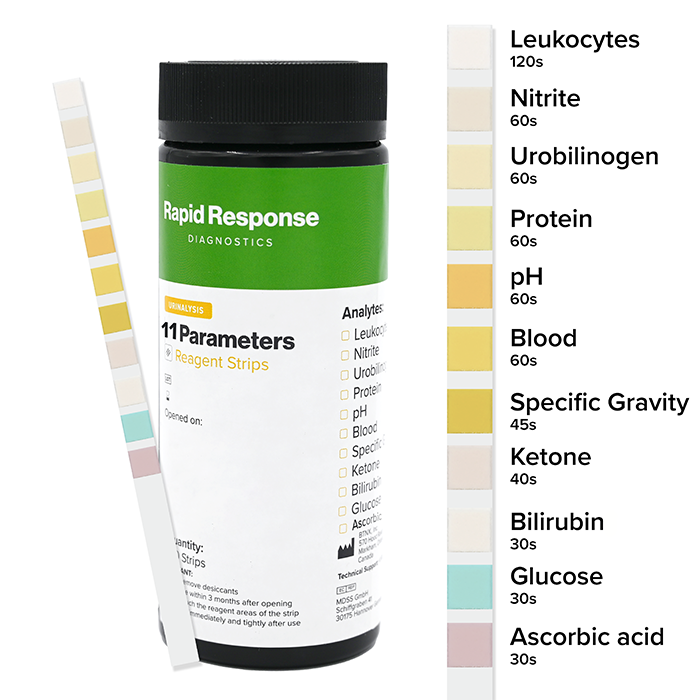
Format: Strip
Kit Size: 100 Tests / Kit
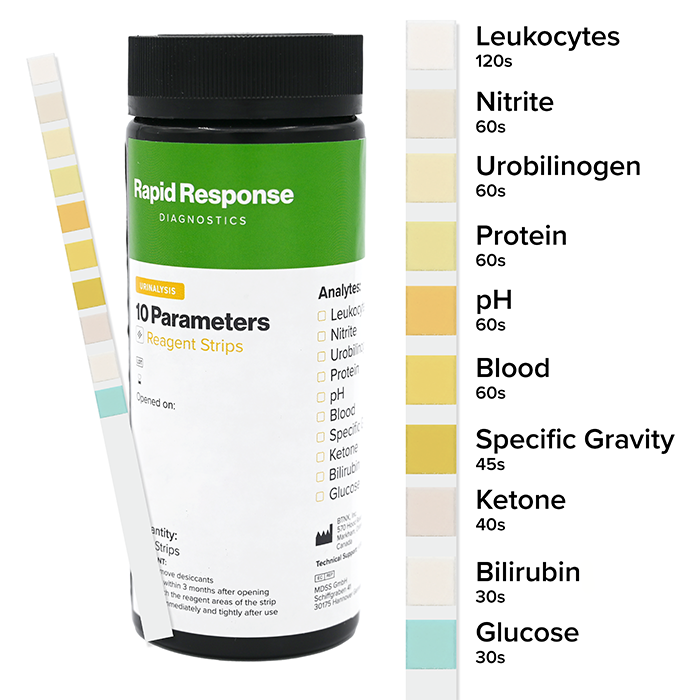
Format: Strip
Kit Size: 100 Tests / Kit
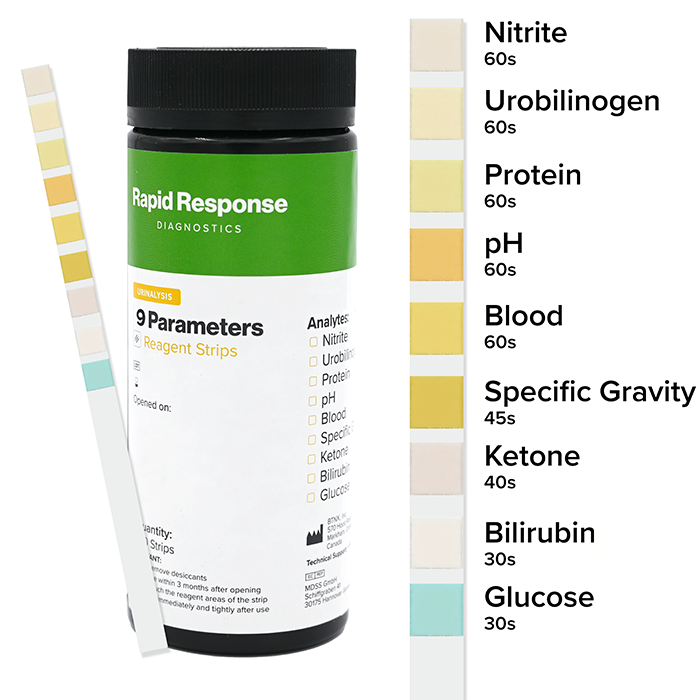
Format: Strip
Kit Size: 100 Tests / Kit
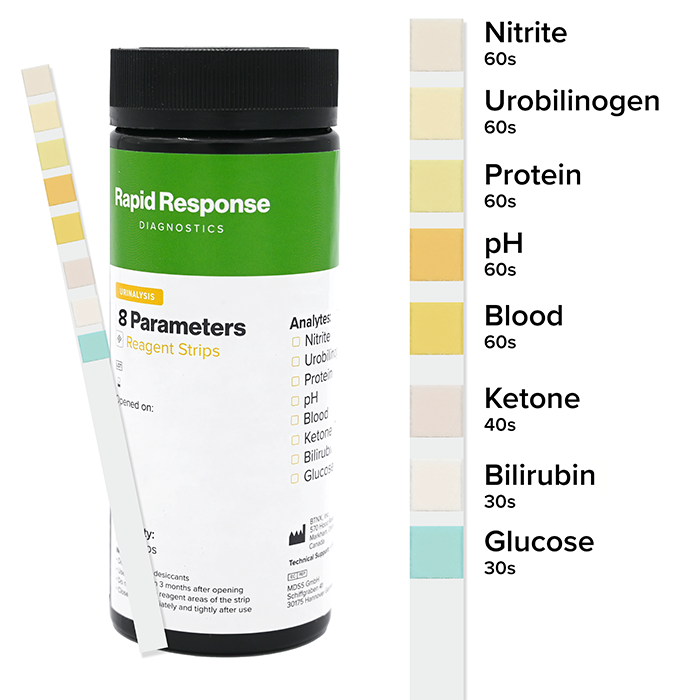
Format: Strip
Kit Size: 100 Tests / Kit
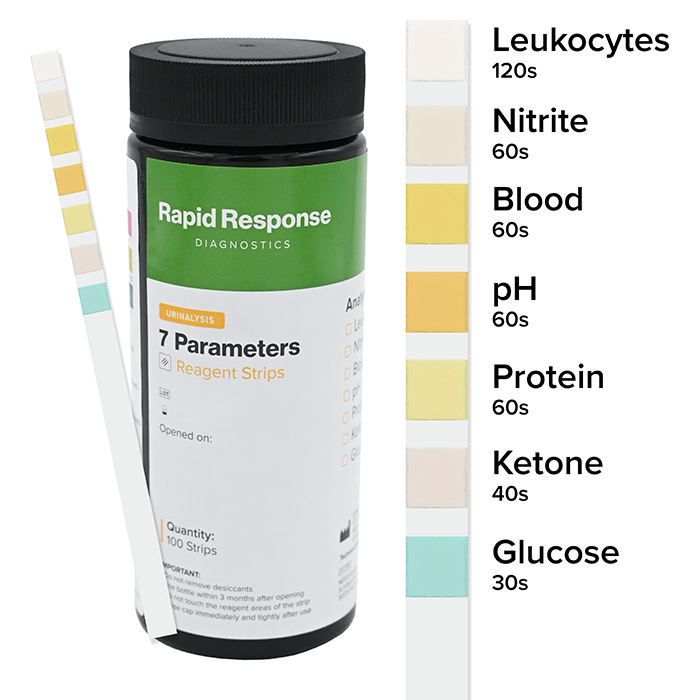
Format: Strip
Kit Size: 100 Tests / Kit
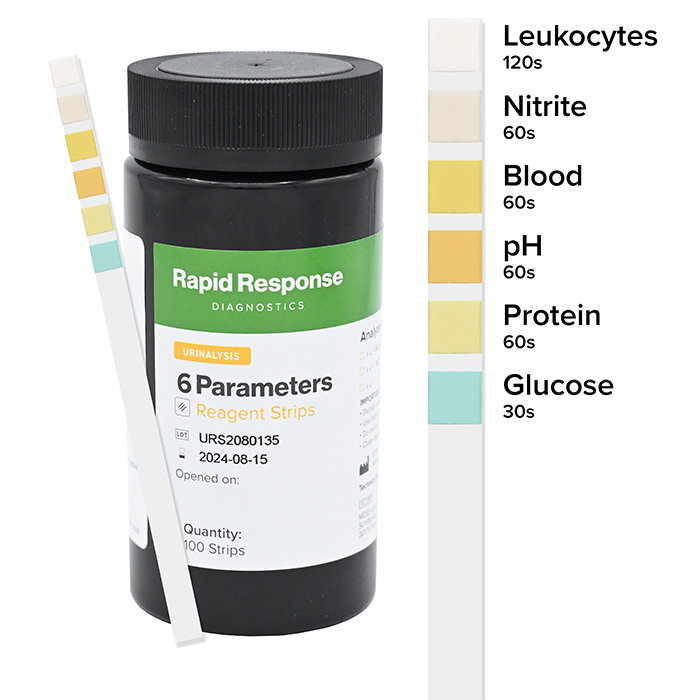
Format: Strip
Kit Size: 100 Tests / Kit
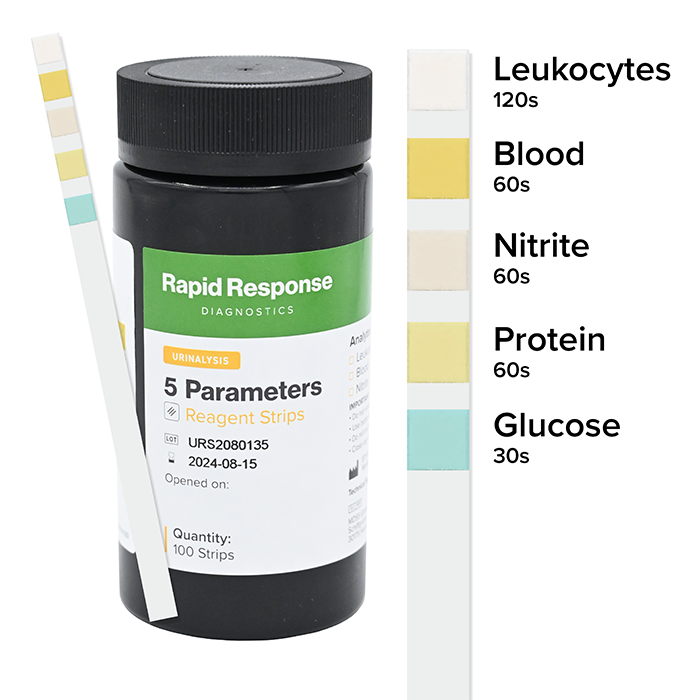
Format: Strip
Kit Size: 100 Tests / Kit
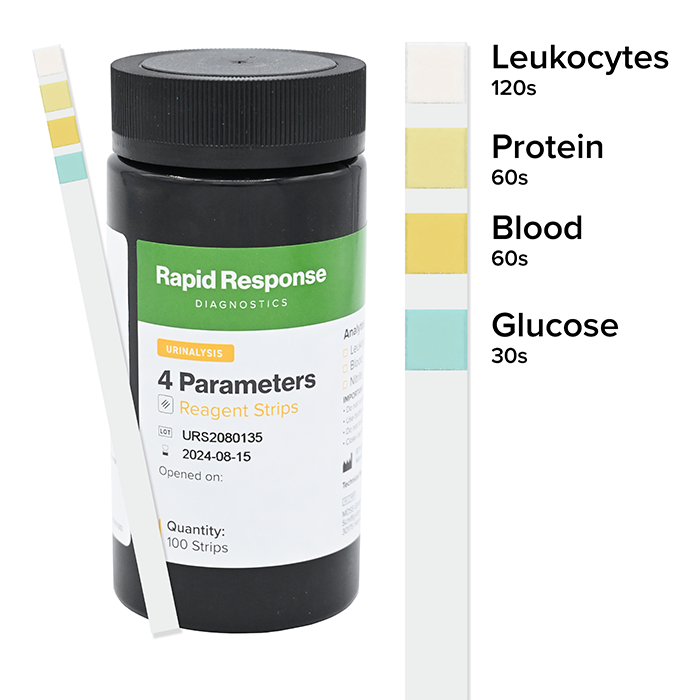
Format: Strip
Kit Size: 100 Tests / Kit
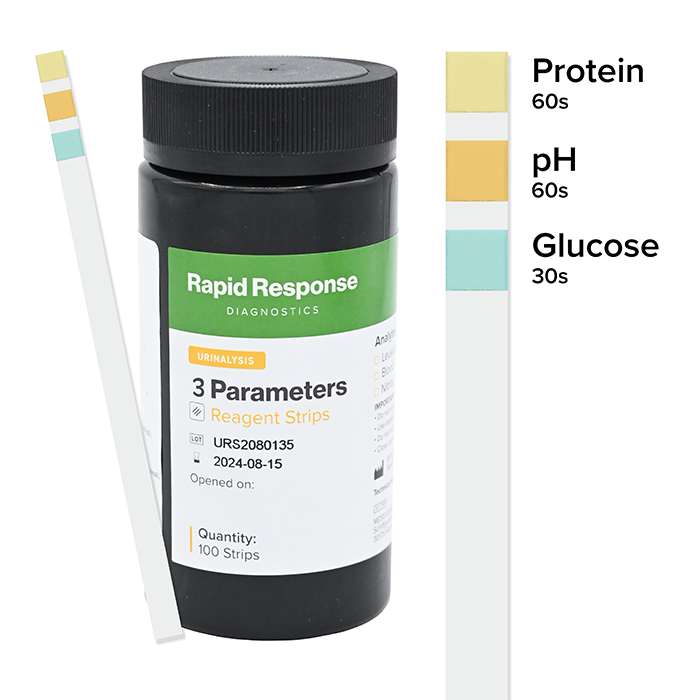
Format: Strip
Kit Size: 100 Tests / Kit
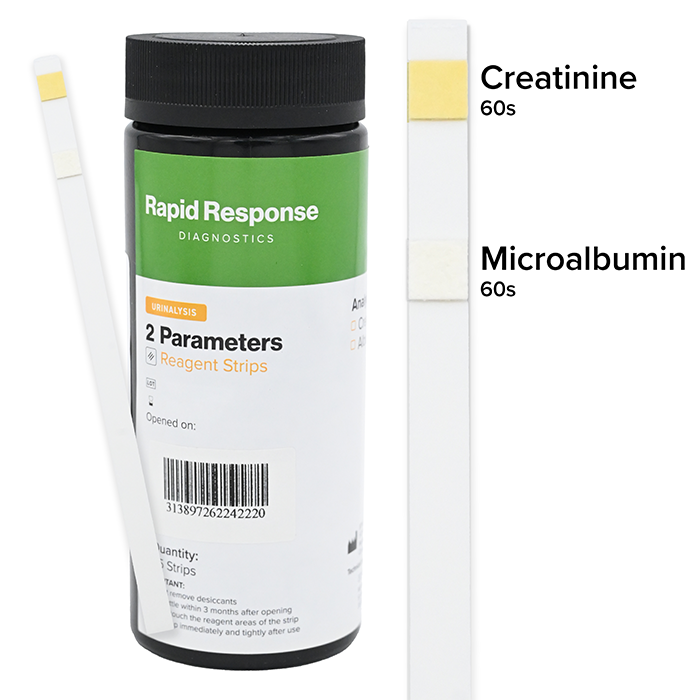
Format: Strip
Kit Size: 25 Tests / Kit
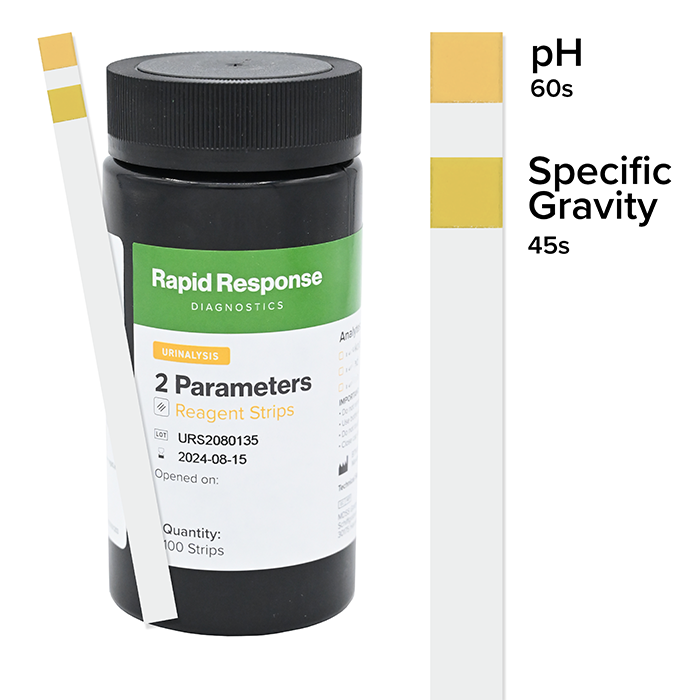
Format: Strip
Kit Size: 100 Tests / Kit
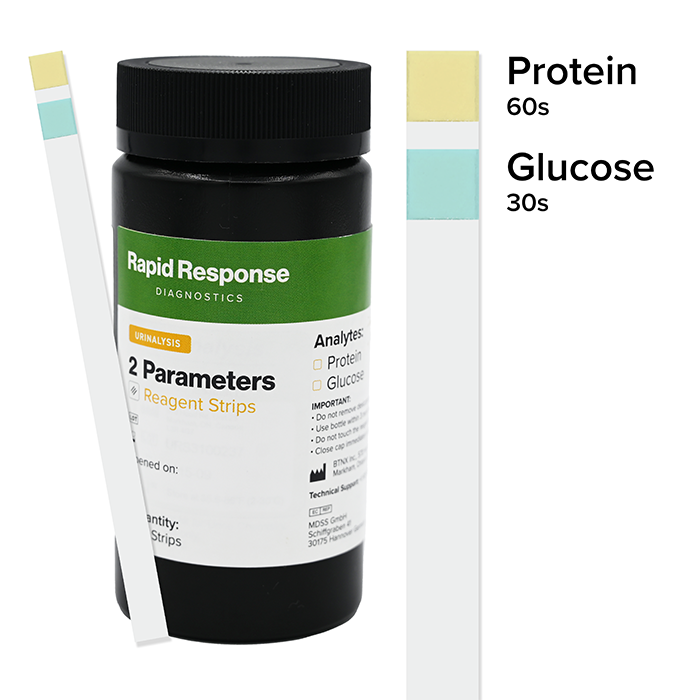
Format: Strip
Kit Size: 100 Tests / Kit
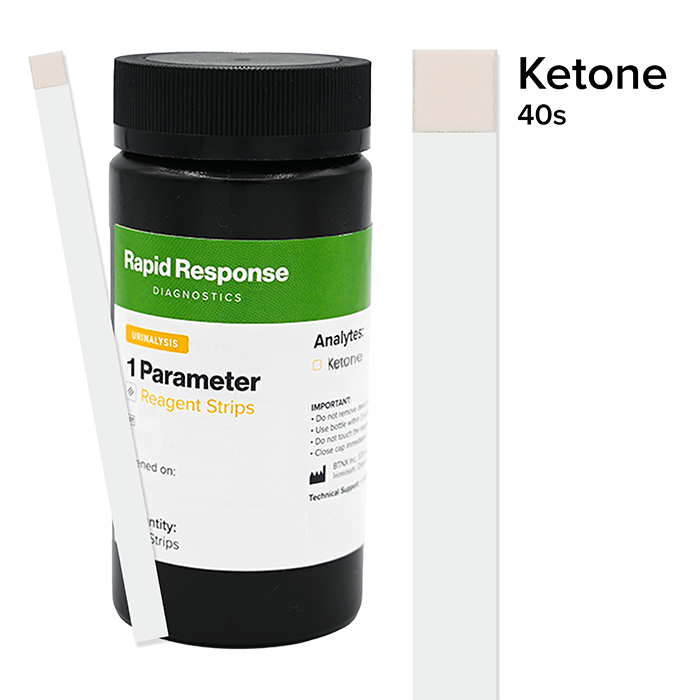
Format: Strip
Kit Size: 100 Tests / Kit
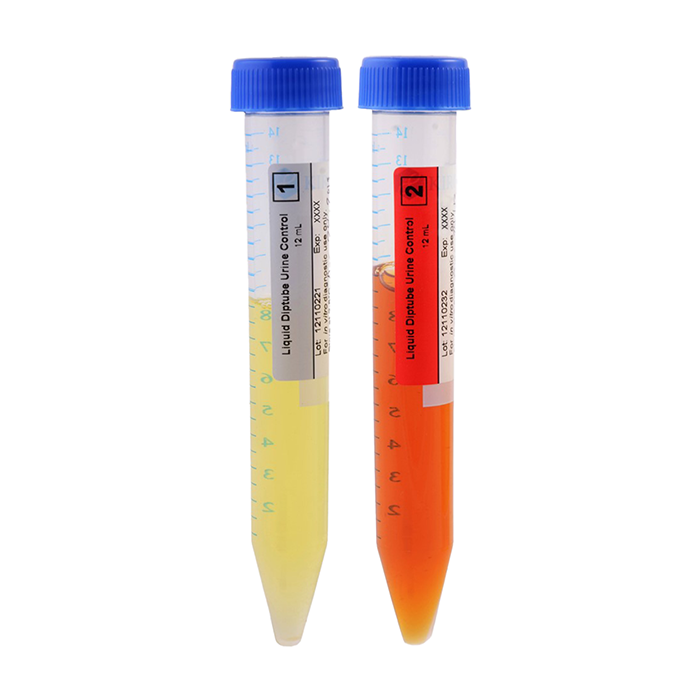
Kit Size: 1 Pair/Kit
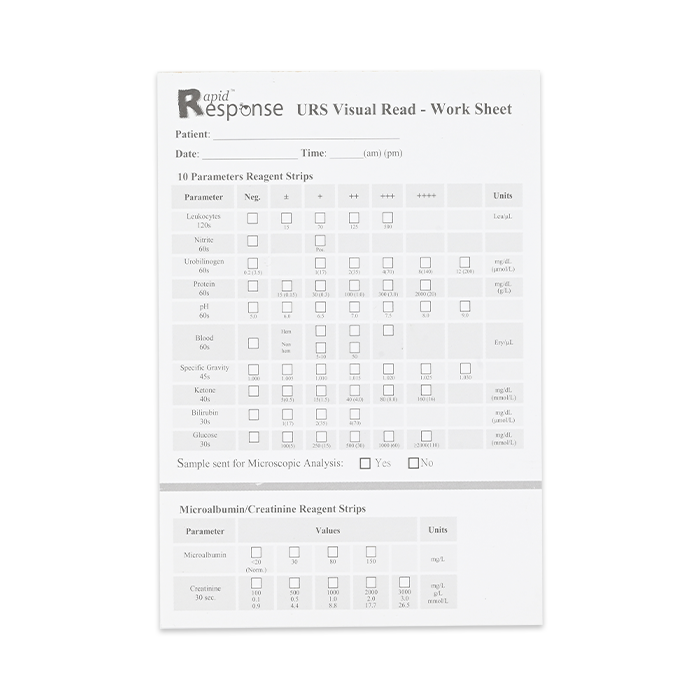
Kit Size: 100 Sheets/Pad
Introduction to Urinalysis Tests
What is a Urine Test?
A urine test, commonly referred to as urinalysis, is a diagnostic examination that involves analyzing the content and components of urine usually through visual comparison of colour blocks.
Urine undergoes many changes during states of disease or body dysfunction before blood composition is altered to a significant extent. Urinalysis is a useful procedure as an indicator of health or disease, and as such, is a part of routine health screening. 1,2
What is a urinary tract infection (UTI)?
A urinary tract infection (UTI) is an infection that affects several parts of the urinary system, including the kidneys, ureters, bladder, and urethra. Infections occur when bacteria, often from the skin or rectum, enter the urethra and infect the urinary tract. 14
Why is it important to test for a UTI?
It is important to test for UTI because if left untreated, it can lead to more serious kidney and health infections. Testing can diagnose if symptoms are of a UTI and help determine the right course of treatment.
What is a Urine Test Strip?
A urine test strip is a narrow piece of plastic embedded with various chemical pads or reagents. When dipped into urine, these pads change colour in the presence of specific substances, allowing for rapid analysis of multiple parameters in the urine.
Urinalysis Reagent Strips are for the qualitative and semi-qualitative detection of one or more of the following analytes in urine: Albumin, Creatinine, Ascorbic Acid, Glucose, Bilirubin, Ketone (Acetoacetic Acid), Specific Gravity, Blood, pH, Protein, Urobilinogen, Nitrite and Leukocytes. The strips are intended for use in screening at-risk patients to assist diagnosis in the following areas: kidney function, urinary tract infections, carbohydrate metabolism (e.g. diabetes mellitus), liver function, acid-base balance and urine concentrations. The results can be used along with other diagnostic information to rule out certain disease states and to determine if microscopic analysis is needed. The strips can be read visually and on Rapid Response U121S Urine Analyzers.
What can urinalysis tests detect?
About the results & interpreting results
Results vary depending on what’s being tested. Use the provided color card in each product to determine results. Abnormal results can indicate:
- Kidney diseases
- Some type of cancer
- Diabetes
- UTIs
- Metabolic problems
About the results & interpreting results
Ascorbic Acid (ASC) 30 Seconds.
This Test detects ascorbic acid as low as 5-10 mg/dL (0.28-0.56 mmol/L).
Patients with adequate diet may excrete 2-10 mg/dL daily. After ingesting large amounts of ascorbic acid, levels can be around 200 mg/dL.
Glucose (GLU) 30 Seconds
Detects glucose as low as 50-100 mg/dL (2.5-5 mmol/L).
Glucose should not be detected in normal urine. Small amounts of glucose may be excreted by the kidney.3 Glucose concentrations as low as 100 mg/dL may be considered abnormal if results are consistent.
Expected Results: Negative
Bilirubin (BIL) 30 Seconds.
Detects bilirubin as low as 0.4-1.0 mg/dL (6.8-17 μmol/L).
In normal urine, no bilirubin is detectable by even the most sensitive methods. Even trace amounts of bilirubin require further investigation. Atypical results (colors different from the negative or positive color blocks shown on the color chart) may indicate that bilirubin-derived bile pigments are present in the urine specimen and are possibly masking the bilirubin reaction.
Expected Result: negative
Ketone (KET) 40 Seconds.
Detects acetoacetic acid as low as 2.5-5 mg/dL (0.25-0.5 mmol/L).
Detectable ketone levels may occur in urine during physiological stress conditions such as fasting, pregnancy and frequent strenuous exercise.4-6 In starvation diets, or in other abnormal carbohydrate metabolism situations, ketones appear in the urine in excessively high concentration before serum ketones are elevated.7
Expected Results: Negative
Specific Gravity (SG) 45 Seconds.
Determines urine specific gravity between 1.000 and 1.030. Results correlate with values obtained by refractive index method within ± 0.005.
Randomly collected urine may vary in specific gravity from 1.003-1.035.8 Twenty-four-hour urine from healthy adults with normal diets and fluid intake will have a specific gravity of 1.016-1.022.8 In cases of severe renal damage, the specific gravity is fixed at 1.010, the value of the glomerular filtrate.
Expected Results: low at 1,000 but normal ranges from 1.020 to 1.030
Blood (BLO) 60 Seconds.
Detects free hemoglobin as low as 0.018-0.060 mg/dL or 5-10 Ery/μL in urine specimens with ascorbic acid content of < 50 mg/dL. Blood is often, but not invariably, found in the urine of menstruating females. The significance of a trace reading varies among patients and clinical judgment is required in these specimens.
Expected result: Negative
pH 60 Seconds
Permits the quantitative differentiation of pH values within the range of 5-9.
This test is based on a double indicator system which gives a broad range of colors covering the entire urinary pH range. Colors range from orange to yellow and green to blue. The expected range for normal urine specimens from newborns is pH 5-7.9 The expected range for other normal urine specimens is pH 4.5-8, with an average result of pH 6.9
Protein (PRO) 60 Seconds
Detects albumin as low as 7.5-15 mg/dL (0.075-0.15 g/L).
1-14 mg/dL of protein may be excreted by a normal kidney.10 A color matching any block greater than trace indicates significant proteinuria. Clinical judgment is required to evaluate the significance of trace results.
Expected result: Negative
Urobilinogen (URO) 60 Seconds
Detects urobilinogen as low as 0.2-1.0 mg/dL (3.5-17 μmol/L).
Urobilinogen is one of the major compounds produced in heme synthesis and is a normal substance in urine. The expected range for normal urine with this test is 0.2-1.0 mg/dL (3.5-17 µmol/L).8 A result of 2.0 mg/dL (35 µmol/L) may be of clinical significance, and the patient specimen should be further evaluated.
Expected result: less than 17 µmol/l (< 1mg/dl)
Nitrite (NIT) 60 Seconds.
Detects sodium nitrite as low as 0.05-0.1 mg/dL in urine with a low specific gravity and less than 30 mg/dL ascorbic acid.
Nitrite is not detectable in normal urine.9 The nitrite area will be positive in some cases of infection, depending on how long the urine specimens were retained in the bladder prior to collection. Retrieval of positive cases with the nitrite test ranges from as low as 40% in cases where little bladder incubation occurred, to as high as approximately 80% in cases where bladder incubation took place for at least 4 hours.
Expected result : Negative
Leukocytes (LEU) 120 Seconds.
Detects leukocytes as low as 9-15 white blood cells Leu/μL in clinical urine.
Normal urine specimens generally yield negative results. Trace results may be of questionable clinical significance. When trace results occur, it is recommended to retest using a fresh specimen from the same patient. Repeated trace and positive results are of clinical significance. The detection of white blood cells in the urine suggests a possible UTI.
Expected result : Negative
Albumin (ALB)
Detects albumin as low as 10mg/mL
A result of 20-200 mg/L may signal microalbuminuria. This may suggest early-stage kidney disease. Results of >200 mg/L indicate clinical albuminuria. These levels may predict albumin excretion rates of 30-300 mg/24 hrs and >300 mg/24 hrs, respectively.4 Exercise, acute illness and fever, and urinary tract infections may raise urine albumin for a time.
Creatinine (CRE) 60 Seconds
Detects creatinine as low as 10mg/mL
In this assay, creatinine reacts with a creatinine indicator in an alkaline condition to form a purplish-brown color complex. The concentration of creatinine is directly proportional to the color intensity of the test pad. A normal urine creatinine level is 10 -300 mg/dL.
Albumin-to-Creatinine Ratio:
30 -300 mg/g (abnormal) shows microalbuminuria. Higher than 300 mg/g (high abnormal) shows clinical albuminuria.5
When a microalbumin or albumin urinalysis test pad turns blue if there is albumin in urine at a constant pH. Results may vary from a pale green to an aqua blue. Normal urine albumin levels are less than 20 mg/L.3 A low level (less than 10 m g/L) will turn the ALB pad white. A result of 20 200 mg/L may signal microalbuminuria. This may suggest early stage kidney disease Results of > 200 mg/L indicate clinical albuminuria. These levels may predict albumin excretion rates of 30 300 mg/24 hrs and >300 mg/24 hrs, respectively.4 Exercise, acute illness and fever, and urinary tract infections may raise urine albumin for a time.
Creatinine is a byproduct of creatinine, primarily used in muscle metabolism. Typically, creatinine is filtered from the body by the kidneys. Creatinine in urine results in a color change from orange through green to blue. A normal urine creatinine level is 10-300 mg/dL. Abnormal low levels of creatinine can indicate kidney disease or other underlying symptoms.
A normal urine albumin to creatinine ratio is less than 30 mg albumin/g creatinine. 30-300 mg/g (abnormal) shows microalbuminuria. Higher than 300 mg/g (high abnormal) shows clinical albuminuria.5
This test is based on azo-coupling reaction of bilirubin with diazotized dichloroaniline in a strongly acidic medium. Varying bilirubin levels will produce a pinkish-tan color proportional to its concentration in urine. In normal urine, no bilirubin is detectable by even the most sensitive methods. Even trace amounts of bilirubin require further investigation. Atypical results (colors different from the negative or positive color blocks shown on the color chart) may indicate that bilirubin-derived bile pigments are present in the urine specimen and are possibly masking the bilirubin reaction.
This test is based on the peroxidase-like activity of hemoglobin which catalyzes the reaction of diisopropylbenzene dihydroperoxide and 3,3’,5,5’-tetramethylbenzidine. The resulting color ranges from light orange to dark green. The significance of a trace results, or a 5 – 10 non-hemolyzed result, varies among patients, and clinical judgment is required for these specimens on an individual basis. Small amounts of blood with a strip result of 1+ hemolyzed, or a 50 Ery/μL non-hemolyzed result, within 60 seconds are sufficiently abnormal to request a further investigation. Blood is often, but not invariably, found in the urine of menstruating females.
This test is based on the enzymatic reaction that occurs between glucose oxidase, peroxidase and chromogen. Glucose is first oxidized to produce gluconic acid and hydrogen peroxide in the presence of glucose oxidase. The hydrogen peroxide reacts with potassium iodide chromogen in the presence of peroxidase. The extent to which the chromogen is oxidized determines the color which is produced, ranging from green to brown. Glucose should not be detected in normal urine. Small amounts of glucose may be excreted by the kidney.6 Glucose concentrations as low as 100 mg/dL may be considered abnormal if results are consistent.
This test is based on ketones reacting with nitroprusside and acetoacetic acid to produce a color change ranging from light pink for negative results to a darker pink or purple color for positive results. Ketones are normally not present in urine. Detectable ketone levels may occur in urine during physiological stress conditions such as fasting, pregnancy and frequent strenuous exercise.7-9 In starvation diets, or in other abnormal carbohydrate metabolism situations, ketones appear in the urine in excessively high concentration before serum ketones are elevated.10
This test is based on a double indicator system which gives a broad range of colors covering the entire urinary pH range. Colors range from orange to yellow and green to blue. The expected range for normal urine specimens from newborns is pH 5-7.12 The expected range for other normal urine specimens is pH 4.5-8, with an average result of pH 6.12
This reaction is based on the phenomenon known as the “protein error” of pH indicators where an indicator that is highly buffered will change color in the presence of proteins (anions) as the indicator releases hydrogen ions to the protein. At a constant pH, the development of any green color is due to the presence of protein. Colors range from yellow to yellow-green for negative results and green to green-blue for positive results. 1-14 mg/dL of protein may be excreted by a normal kidney.13 A color equal to or greater than 30mg/dL indicates significant proteinuria. Clinical judgment is required to evaluate the significance of trace results.
This test is based on a modified Ehrlich reaction between p-diethylaminobenzaldehyde and urobilinogen in strongly acidic medium to produce a pink color. Urobilinogen is one of the major compounds produced in heme synthesis and is a normal substance in urine. The expected range for normal urine with this test is 0.2-1.0 mg/dL (3.5-17 µmol/L).11 A result of 2.0 mg/dL (35 µmol/L) may be of clinical significance, and the patient specimen should be further evaluated.
This test depends upon the conversion of nitrate to nitrite by the action of gram-negative bacteria in the urine. In an acidic medium, nitrite in the urine reacts with p-arsanilic acid to form a diazonium compound. The diazonium compound in turn couples with 1 N-(1-naphthyl) ethylenediamine to produce a pink color. Nitrite is not detectable in normal urine.9 The nitrite area will be positive in some cases of infection, depending on how long the urine specimens were retained in the bladder prior to collection. Retrieval of positive cases with the nitrite test ranges from as low as 40% in cases where little bladder incubation occurred, to as high as approximately 80% in cases where bladder incubation took place for at least 4 hours.
This test reveals the presence of granulocyte esterases. The esterases cleave a derivatized pyrazole amino acid ester to liberate derivatized hydroxy pyrazole. This pyrazole then reacts with a diazonium salt to produce a beige-pink to purple color. Normal urine specimens generally yield negative results. Trace results may be of questionable clinical significance. When trace results occur, it is recommended to retest using a fresh specimen from the same patient. Repeated trace and positive results are of clinical significance.
A urine analyzer is a device that automatically examines urine test strips. It uses reflectance photometry to interpret the colour changes on the strip and provides a quantitative or semi-qualitative result.
The Rapid Response U121S Urine Analyzer is an efficient and accurate tool for interpreting Rapid Response Urinalysis Reagent Strips results. With the ability to read, store, and print results in under two minutes, the U121S Urine Analyzer improves workflow efficiency while reducing the chance of human error.
Yes, urinalysis can detect white blood cells or nitrites, which are indicative of UTIs.

 Canada
Canada